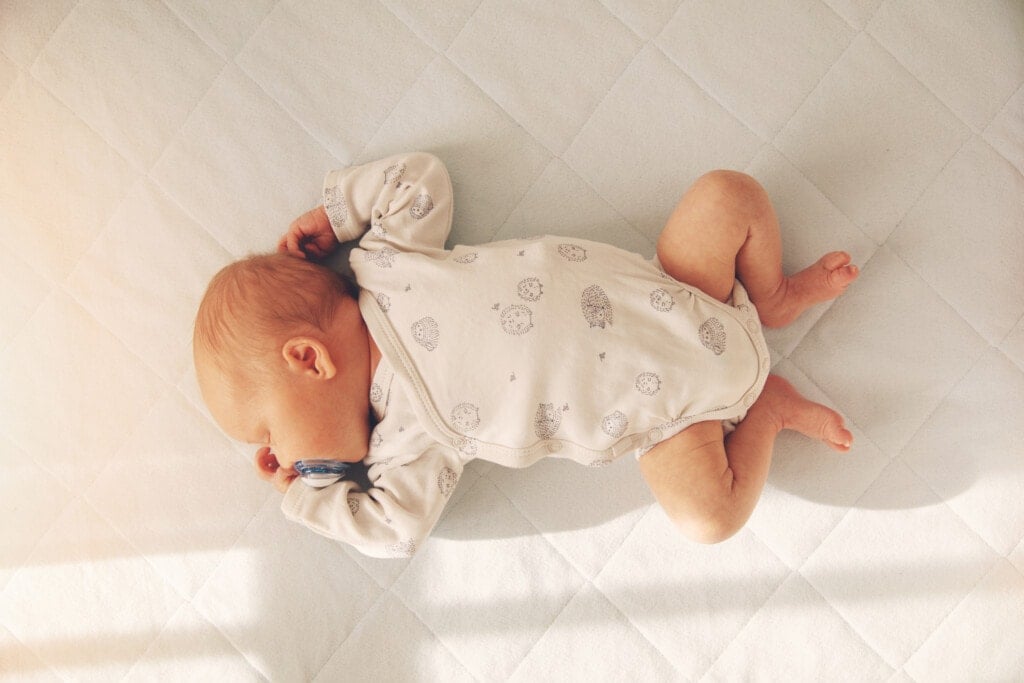Ahhhh, newborns! They smell amazing, and they are so cute. But why is their sleep all over the place? As a Pediatrician and Enfamil NeuroPro’s Infant Development Expert, I often get asked the same questions about newborn sleep patterns:
- When will they start sleeping in longer stretches?
- Why do they have nights and days mixed up?
- When can I get them on a schedule?
- Why do they startle so easily in their sleep?
Sometimes knowing WHY newborns do the things they do can help you understand this very normal sleep phase and approach it with more patience and understanding.
Newborn Sleep Patterns
Understanding Sleep Stages
The first step to understanding newborn sleep patterns is to understand sleep stages. In that fourth trimester (0-3 months), babies have a light and deep stage of sleep. After four months, they transition to more sleep cycles (similar to adults).
In the light stage, infants’ eyes are closed, but they are asleep, and they are more likely to be aroused with noise or maybe even their own arms in their face. They startle much more easily in this phase, but as they get older and they develop more sleep stages, this quick arousal will not be as prominent.
In the deep stage of sleep, it is much more difficult to wake them up.
Why is understanding these sleep stages critical? Well, newborn babies often start in light sleep, and they can make grunts, deep exhales, or noises during this light stage of sleep. Parents think the baby is ready to wake up and arouse them, disrupting their sleep. As adults, we also go through sleep cycles and toss and turn. Babies can move through sleep cycles and make sounds, BUT they will go back down independently. By pausing, we see if they will, in fact, go down on their own or need something like a feeding.
Practice Pausing
It’s important in the newborn phase and beyond to practice pausing. Pausing means taking a moment before you respond to your newborn when sleeping. If they make a grunt, wail, or sound, give 30 seconds to 5 minutes before you attend to them in their safe sleep environment. If you know they are due for a feeding, you can shorten that pause, but we often equate noises in sleep with hunger or wanting to be awake, so pausing can help assure they genuinely need our assistance.
Know the Signs of Tiredness
In the first three months, babies can sleep anywhere from 14-18 hours a day. This includes nighttime sleep and naps. Early on, they will be awake for shorter periods. Many newborns under eight weeks will be awake 45 min to 1 hour before going to sleep again. It’s very important to watch for signs of tiredness in that time frame so you can lay baby down to sleep.
These signs include rubbing their eyes, zoning out or staring into space, or red eyebrows and eyes. When you notice these signs, it’s important to lay them down in their safe sleep environment like a crib or bassinet to reinforce ‘downtime.’ When you lay them there, pause. If they cry, give them 30 seconds to 5 minutes before you pick them back up. If you lay them down and they’re looking around, allow them to do so. They get comfortable with their new sleep space, which is essential to teach independent sleep.
Help Baby Get Nights and Days Straight
Babies commonly have their nights and days mixed up where they sleep more during the day and less at night because of the lack of melatonin. Melatonin usually develops after four weeks when they get more into a rhythm. Parents often want to switch this around early but be patient with them, especially in that first month. They WILL learn the difference between night and day, and the following tips can help guide them and get them to sleep in longer stretches by two months of age!
Embrace the darkness.
When your baby is sleeping, make sure it’s dark. Blackout curtains do wonders. During diaper changes/feeding in the middle of the night, keep lights to a minimum. Just enough to do what you need to do and lay them back down. When baby is awake, allow sunlight and get outdoors as well. Sunlight will help prime them for sleep and help establish that sleep-wake cycle (we sleep during the night and are more awake during the day).
Let baby sleep at night.
Once baby has met their birth weight, YOU DO NOT NEED TO WAKE THEM UP TO FEED. Clear this with your child’s clinician if you are unsure. This means that if they are sleeping overnight, let them sleep. If they wake up and are hungry, feed them. For purposes of this rule, nighttime sleep is considered 7 pm to 7 am, although your baby will not sleep that long at one month of age. When you wake them up to feed, you are not allowing their natural sleep patterns to occur and inadvertently disrupt their sleep.
Wake up a sleeping baby during the day.
Wait, what? I just said to let them sleep! That’s at nighttime. During the day, wake them up every 2-3 hours to be fed. This rhythm can be possible after one month of age. A great rhythm is offering a feeding at 7 am, 10 am, 1 pm, 4 pm, and 7 pm for the daytime feeds. Once breastfeeding is established, this will be their likely routine and can also be used for formula-fed babies! This helps move out of day-and-night confusion that can take four-six weeks to sort out. Of course, babies may cluster feed or go off this routine, and that’s NORMAL! They’re not robots! Please feed them if they are hungry.
Practice pausing.
Yes, I’m repeating this because it’s important. If they are crying or making any sound, practice pausing. Pausing is very helpful in that by stopping and listening to the cry, you will begin to learn what each cry means. By jumping at every cry, you will never know if it means your baby is hungry, needs a diaper change, or is going into another sleep cycle. Pausing can help if you are trying to teach them to settle into a new sleep space. Also, it helps when they are in-between sleep cycles, and you are determining if they are actually up or if they will settle back down on their own.
By using these techniques and understanding newborn sleep patterns, you could see sleep stretches by two months of age. Every baby is unique as to how long they will sleep overnight by this age, but we parents can help guide them into these healthy sleep foundations.














